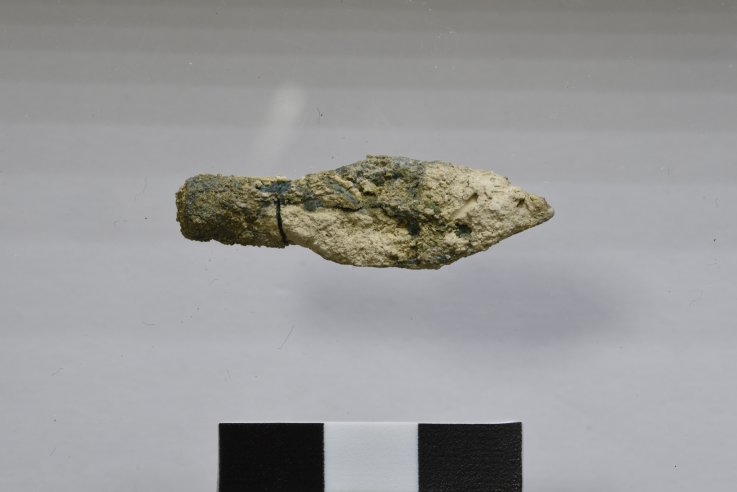JEWELRY FROM ANCIENT BABYLONIAN DESTRUCTION OF JERUSALEM BY NEBUCHADNEZZAR UNEARTHED AT MOUNT ZION
Aremarkable object—an intricate piece of jewelry delicately made out of gold and silver—came to light in recent excavations in Jerusalem by archaeologists at the University of North Carolina at Charlotte. Intriguingly, it came from an ashy layer mixed with broken pottery vessels together with iron and bronze arrowheads.
This was evidence of the Babylonian conquest of Jerusalem by Nebuchadnezzar in 587/586 BC, which led directly to the destruction of the Temple of God, originally built by Solomon, and eventually also to the exile of all the city inhabitants to Babylon located more than 500 miles away (present-day Iraq).
Every year religious Jews in Jerusalem and across the world gather together to pray, mourn and fast in remembrance of the destruction of the Jewish Temple to God.
This is called Tisha B' Av (the ninth day in the Hebrew month of Av) according to the Jewish calendar, and this year the date fell on August 11. The first destruction of the Temple by Nebuchadnezzar is foremost in their minds.
The ashy layer we were digging resulted from the collapse of wooden rafters of a house that went up in flames in the aftermath of the Babylonian siege. One can reconstruct the scene: soldiers running through the streets killing everyone in sight, raping, plundering and then razing the walls of the houses. Dramatic stuff indeed.
It was an ugly scene, and one that has been repeated again and again through the centuries. Jerusalem has always been a city of conflict.
The ashy layer found in Jerusalem highlights the turmoil existing at that time in the Middle East in the sixth century BC. Nebuchadnezzar II, once he ascended the Babylonian throne in 605 BC, spent many years campaigning with his army in the Levant, aimed at curbing the strength and influence of Egypt in the region. He is of course well known for his destruction of Solomon's Temple in Jerusalem, and in the Bible had a reputation as a "destroyer of nations" (Jeremiah 4:7).
But Nebuchadnezzar is not just a character taken from the Bible. The actual site of Babylon, with its palaces and temples, has been excavated by archaeologists in Iraq, and inscriptions mentioning Nebuchadnezzar are known—notably an inscribed cylinder object recording his building works at Babylon in the collection of the British Museum in London.
The Bible relates that the besieged city of Jerusalem was hit hard by famine and the suffering was enormous: "So the city was besieged unto the eleventh year of King Zedekiah. On the ninth day of the [fourth] month the famine was sore in the city, so that there was no bread for the people of the land. Then a breach was made in the city, and all the men of war [fled] by night by the way of the gate between the two walls...And he [Nebuzaradan, the Babylonian captain of the guard] burnt the house of the Lord, and the King's house; and all the houses of Jerusalem, even every great man's house, burnt he with fire." (2 Kings 25: 1-9).
Archaeologists enjoy digging destruction levels and especially those resulting from battles or catastrophes—it is within these layers that the best finds are sometimes made. The iron and bronze "Scythian" type arrowheads are a case in point, which are chronologically quite specific.

However, the piece of gold and silver jewelry was unexpected. It is no more than an inch in diameter, but it does have enormous implications for the social history of the biblical period. The jewelry was extremely well made and it consists of a domed upper part made out of gold, now slightly squashed, and fixed below it is what looks like a bunch of grapes made of silver. It must have been lost during the plunder of the city.

Was this an earring or perhaps a tassel for a garment? Did it belong to a man or woman? We cannot really be sure at this point, but one thing is certain: it did belong to a member of the rich Judahite elite of the city—and that prior to the conquest of the city there must have been a house at the location we are digging. Perhaps this was one of the "Great Man's houses" mentioned in the Bible. I cannot wait to see what we come across in the next season of work at the site, scheduled for the Summer of 2020, when we expand the area of digging.
What archaeology does well is to fill in the gaps of our historical knowledge—it provides us with information about day-to-day events, and it lends color to the biblical account.
And there is the drama: I was able to hold in my hands the ashes from the destruction of Jerusalem by Nebuchadnezzar. It is truly an exhilarating experience.

No comments:
Post a Comment